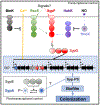A lasting symbiosis: how Vibrio fischeri finds a squid partner and persists within its natural host
- PMID: 34089008
- PMCID: PMC8529645
- DOI: 10.1038/s41579-021-00557-0
A lasting symbiosis: how Vibrio fischeri finds a squid partner and persists within its natural host
Abstract
As our understanding of the human microbiome progresses, so does the need for natural experimental animal models that promote a mechanistic understanding of beneficial microorganism-host interactions. Years of research into the exclusive symbiosis between the Hawaiian bobtail squid, Euprymna scolopes, and the bioluminescent bacterium Vibrio fischeri have permitted a detailed understanding of those bacterial genes underlying signal exchange and rhythmic activities that result in a persistent, beneficial association, as well as glimpses into the evolution of symbiotic competence. Migrating from the ambient seawater to regions deep inside the light-emitting organ of the squid, V. fischeri experiences, recognizes and adjusts to the changing environmental conditions. Here, we review key advances over the past 15 years that are deepening our understanding of these events.
© 2021. Springer Nature Limited.
Conflict of interest statement
Competing interests
The authors declare no competing interests.
Figures




Comment in
-
Beating in on a stable partnership.Nat Rev Microbiol. 2021 Oct;19(10):619-620. doi: 10.1038/s41579-021-00575-y. Nat Rev Microbiol. 2021. PMID: 34089009 No abstract available.
Similar articles
-
A lasting symbiosis: how the Hawaiian bobtail squid finds and keeps its bioluminescent bacterial partner.Nat Rev Microbiol. 2021 Oct;19(10):666-679. doi: 10.1038/s41579-021-00567-y. Epub 2021 Jun 4. Nat Rev Microbiol. 2021. PMID: 34089010 Free PMC article. Review.
-
Euprymna berryi as a comparative model host for Vibrio fischeri light organ symbiosis.Appl Environ Microbiol. 2025 Aug 20;91(8):e0000125. doi: 10.1128/aem.00001-25. Epub 2025 Jul 10. Appl Environ Microbiol. 2025. PMID: 40637409 Free PMC article.
-
Adaptation to pH stress by Vibrio fischeri can affect its symbiosis with the Hawaiian bobtail squid (Euprymna scolopes).Microbiology (Reading). 2020 Mar;166(3):262-277. doi: 10.1099/mic.0.000884. Microbiology (Reading). 2020. PMID: 31967537 Free PMC article.
-
Insights into flagellar function and mechanism from the squid-vibrio symbiosis.NPJ Biofilms Microbiomes. 2019 Oct 25;5(1):32. doi: 10.1038/s41522-019-0106-5. eCollection 2019. NPJ Biofilms Microbiomes. 2019. PMID: 31666982 Free PMC article. Review.
-
Using Colonization Assays and Comparative Genomics To Discover Symbiosis Behaviors and Factors in Vibrio fischeri.mBio. 2020 Mar 3;11(2):e03407-19. doi: 10.1128/mBio.03407-19. mBio. 2020. PMID: 32127462 Free PMC article.
Cited by
-
"Failure To Launch": Development of a Reproductive Organ Linked to Symbiotic Bacteria.mBio. 2023 Feb 28;14(1):e0213122. doi: 10.1128/mbio.02131-22. Epub 2023 Jan 19. mBio. 2023. PMID: 36656023 Free PMC article.
-
sRNA chaperone Hfq controls bioluminescence and other phenotypes through Qrr1-dependent and -independent mechanisms in Vibrio fischeri.Gene. 2022 Jan 30;809:146048. doi: 10.1016/j.gene.2021.146048. Epub 2021 Oct 29. Gene. 2022. PMID: 34756963 Free PMC article.
-
A mutualistic model bacterium is lethal to non-symbiotic hosts via the type VI secretion system.bioRxiv [Preprint]. 2024 Dec 14:2024.12.13.628426. doi: 10.1101/2024.12.13.628426. bioRxiv. 2024. Update in: mBio. 2025 May 14;16(5):e0015725. doi: 10.1128/mbio.00157-25. PMID: 39713446 Free PMC article. Updated. Preprint.
-
A lasting symbiosis: how the Hawaiian bobtail squid finds and keeps its bioluminescent bacterial partner.Nat Rev Microbiol. 2021 Oct;19(10):666-679. doi: 10.1038/s41579-021-00567-y. Epub 2021 Jun 4. Nat Rev Microbiol. 2021. PMID: 34089010 Free PMC article. Review.
-
How It All Begins: Bacterial Factors Mediating the Colonization of Invertebrate Hosts by Beneficial Symbionts.Microbiol Mol Biol Rev. 2022 Dec 21;86(4):e0012621. doi: 10.1128/mmbr.00126-21. Epub 2022 Oct 27. Microbiol Mol Biol Rev. 2022. PMID: 36301103 Free PMC article. Review.
References
Publication types
MeSH terms
Grants and funding
LinkOut - more resources
Full Text Sources
Research Materials
Miscellaneous

